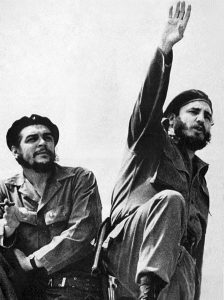The thinking of Comrade F. Dobler from the early 20th century remains relevant and even prescient: those who need open access to information may be those who are fundamentally excluded from public libraries.

To defend the revolution is to defend culture
Having considered the cultural policies of Ontario and the U.K., I would now like to turn my attention to Cuba, where culture has been a pillar of the Revolution—along with education, health and social care—since 1959. In line with Marxist thinking, the ideological superstructure in Cuba is determined by the economic base. The socialist economy has shaped the revolutionary approach to culture, which:

- Belongs to everyone (as both spectators and creators) rather than being limited to an elite minority
- Should be detached from the market economy (copyright was revoked from 1967 to 1975, in a bid to provide access to the best of the world’s literature, and grants for artists were implemented from 1961)
- Is a form of social production (with humanity’s happiness as its end product)
- Stimulates not only social but economic development (by increasing the cultural levels of the population in a country emerging from underdevelopment)
- Promotes revolutionary (and hence critical) thinking
If we look at the ways in which these basic principles played out in real terms, we find that in February 1959, one month after the Revolution triumphed, the National Museum of Fine Arts was reorganised. In March 1959, film began to be understood as an art form in its own right and the Cuban Institute of Cinematic Arts and Industries (ICAIC) was established. In 1960, in anticipation of an ideological blockade, after the US imposed an economic embargo which remains in place today, a Pan-American cultural house (Casa de las Americas) was opened.
The March of the Pencils
In 1960, Fidel Castro declared that Cuba would be free of illiteracy within one year, a feat which many said was impossible. A quarter of a million mainly young people went out into the countryside to teach the peasant population to read and write, while also closing the gaps between urban and rural areas, and between intellectual and manual workers. At the March of the Pencils in Havana in 1961, Fidel was able to announce that Cuba was the first Third World country to have a fully literate population.
Tens of thousands of arts teachers, many of whom had taken part in the literacy campaign, were trained at National Arts Schools to disseminate creative skills to farms, factories and workplaces throughout the island, responding to what Fidel called the transition from spectators to creators. At the heyday of this program, an estimated one million amateur artists were operating within a population of around six million. This program continues today, centred on the Casas de Cultura that exist in every town, and anyone can request time off work to attend the National Arts Schools for a week of professional training.
The National Library was established on Revolution Square in Havana, placing books, libraries and reading at the very heart of the Revolution. It was at a meeting held at the National Library in June 1961, in his ‘Words to the Intellectuals’, that Fidel formulated the Revolution’s approach to creative expression through the slogan, “Within the Revolution, everything; Against the Revolution, nothing.” In other words, any cultural form or content within the socialist Revolution (which was proclaimed after the abortive Bay of Pigs invasion in April 1961) was possible. But any attempt to use culture against the Revolution would be vigorously opposed.
Cultural policy
It is important to note that cultural policy—the operational principles laid down for culture by the state—did not begin to be formulated in Cuba until after the key cultural institutions (ICAIC, Casa de las Americas, the National Library etc.) had been established. This is typically unconventional as normally policy would be laid down and institutions devised to fit this policy. As such, this approach is significant for two reasons. Firstly, it meant that the institutions were initially guided only by the general ideas which had been established for culture, rather than being beholden to any overarching administrative authority. Secondly, the delay in forming cultural policy meant that, when this did happen, there was scope for a more discursive approach. A key moment for this was the First National Congress of Writers and Artists in August 1961, which, as the name suggests, was organised by the country’s writers and artists rather than being a top down affair. At this event the participants firmly implicated their work in the social justice aims of the Revolution: To defend the Revolution is to defend culture.
Marxist-humanist cultural policy, as it has been uniquely formulated in Cuba, is underwritten by the conviction that those taking up mental labour might emerge from any sector of society. This democratising impulse implies that passive spectatorship of, and active engagement in, creative production are necessary to human fulfilment. At the same time, the conception of culture as a form of social production and of the artist and writer as an integral member of society endures.
John Pateman is the CEO of the Thunder Bay Public Library. He is also the author of the Open for All? column in Open Shelf.
